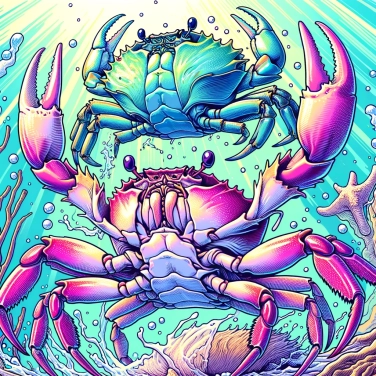Crabs regularly change their shell, a process called molting, in order to grow and reproduce. By shedding their old shell, they can develop and adapt to their environment.

Crabs have a hard shell called an exoskeleton, which supports their body but does not grow with them. To grow, they have no choice: they must literally crawl out of their old shell to make a new one. This process is called molting. During this phase of change, the crab absorbs a lot of water to swell its soft body, then it slowly and carefully pulls itself out of its old armor. Afterward, it will remain vulnerable for a few days, until the new shell hardens properly. This phenomenon occurs multiple times in its life, especially when it is young and growing.
Crabs regularly shed their exoskeleton as a result of their growth. Since their rigid exoskeleton does not grow with them, they must get rid of the one that becomes too tight in order to manufacture a new, more spacious one. Hormones play a major triggering role: when a crab feels that its body space is becoming really limited, its body releases chemical substances that initiate the process. Other factors can accelerate molting, such as a change in temperature, an increase in food availability, or even stress related to the threat of a predator.
Regularly changing their shell allows crabs to ensure their growth, as they cannot grow inside a rigid and fixed armor. Each molt is an opportunity for them to exit their old shell, which has become too small, providing their body with the necessary space to develop and become larger and stronger. The new shell is initially soft and flexible, then gradually hardens, thus creating a solid protection suited to their size. It is also the ideal occasion to repair or replace accumulated damage, such as cracks or broken parts. In other words, molting is a vital kind of renewal, allowing the crab to evolve as it grows, and to be perfectly adapted to its new dimensions while ensuring effective protection.
The period when the crab sheds its shell, called molting, is a super delicate moment. When it loses its old protection, it becomes soft and vulnerable for a few hours to several days. It's tough because, at that moment, the crab becomes an easy prey for predators like fish, birds, or even other crabs. Without its solid shell, its soft body offers no protection, and it is also at risk of getting easily injured. Additionally, small issues like infections or parasites can take advantage of this temporary weakness. In short, molting is a bit of a risky operation where timing and location must be perfect to avoid trouble.
Crabs often consume their old exoskeleton after molting. This behavior allows for the valuable recovery of calcium and other essential minerals to quickly strengthen the still fragile new shell.
During the molting period, crabs generally hide because their new shell is soft and does not effectively protect them from predators. This can last from a few hours to a few days, depending on the species.
The molting process allows crabs to grow because their old rigid shell cannot stretch or adapt to their growth. They can increase their size by 10 to 25% with each shell change!
Did you know that the coconut crab, the largest terrestrial crab, molts throughout its life, but the frequency decreases significantly with adulthood? Young crabs molt several times a year, while adults may only molt once every two years.
After molting, the new shell can remain soft and vulnerable for several hours, or even several days, depending on the species and the age of the crab. During this delicate period, the crab usually hides to protect itself from predators until its shell becomes sufficiently hard.
It's best not to intervene directly during a crab's molting process, which is a natural but delicate procedure. In captivity, it's advisable to provide a calm, humid, and suitable environment. Ensure that the crab has shelter and avoid disturbing it until its new shell has hardened.
A crab about to molt shows several precursor signals: decreased appetite, increased inactivity, and its shell may become duller or cloudier. In some species, crabs often dig burrows or shelters for the molting period.
Indeed, some molts can go poorly, especially if the crab is weakened by illness, environmental stress, or nutritional deficiencies. In this case, the shell may detach only partially, seriously risking injury or even death for the animal. If such an incident occurs in captivity, it may be helpful to consult an aquarium expert or a specialized veterinarian.
The frequency of molting mainly depends on the age and species of the crab. Young crabs molt frequently, sometimes every week or month. As they age, the intervals between molts become longer and can become annual or even rarer in some adult species.

100% of respondents passed this quiz completely!
Question 1/5